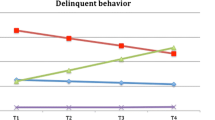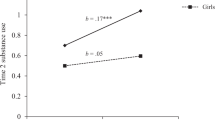Abstract
Though recent research has highlighted prosocial behavior as negatively associated with problem behavior during adolescence, we know little about how these variables might be associated longitudinally, whether there are bidirectional effects, and whether there might be different patterns of co-occurrence of behaviors for different individuals. Thus, the current study examined relations between prosocial and problem behaviors in three different ways in an attempt to better understand these associations. Participants included 500 adolescents recruited from a Northwestern state in the USA who took part in the study every year from age 12 to 18 (50% female, 67% European American). Growth curve analyses suggested that change in prosocial behavior was negatively associated with change in aggression and delinquency over time. A longitudinal panel model suggested that prosocial behavior and aggression were negatively associated bidirectionally, and that prosocial behavior was negatively associated with delinquency over time. Finally, mixture modeling conducted at ages 12, 15, and 18 revealed heterogeneity in the ways in which prosocial and problem behaviors co-occur. The discussion focuses on the complexity of interrelations between prosocial behavior and problem behavior across adolescence.



Similar content being viewed by others
References
Arsenio, W. F., & Lemerise, E. A. (2004). Aggression and moral development: Integrating social information processing and moral domain models. Child Development, 75(4), 987–1002.
Barber, B. L., Eccles, J. S., & Stone, M. R. (2001). Whatever happened to the jock, the brain, and the princess? Young adult pathways linked to adolescent activity involvement and social identity. Journal of Adolescent Research, 16(5), 429–455.
Barber, B. K., Stolz, H. E., Olsen, J. A., & Maughn, S. L. (2005). Parental support, psychological control, and behavioral control: Assessing relevance across time, culture, and method. Monographs of the Society for Research in Child Development, 70(4), i–147.
Barker, E. D., Oliver, B. R., & Maughan, B. (2010). Co-occuring problems of early onset persistent, childhood limited, and adolescent onset conduct problem youth. Journal of Child Psychology and Psychiatry, 51, 1217–1226.
Berger, C., Batanova, M., & Cance, J. D. (2015). Aggressive and prosocial? Examining latent profiles of behavior, social status, Machiavellianism and empathy. Journal of Youth and Adolescence, 44(12), 2230–2244. doi:10.1007/s10964-015-0298-9.
Carlo, G., Crockett, L. J., Randall, B. A., & Roesch, S. C. (2007). A latent growth curve analysis of prosocial behavior among rural adolescents. Journal of Research on Adolescence, 17(2), 301–324.
Carlo, G., Crockett, L., Wilkinson, J., & Beal, S. (2011). The longitudinal relations between rural adolescents’ prosocial behaviors and young adult substance use. Journal of Youth and Adolescence, 40(9), 1192–1202.
Carlo, G., Mestre, M. V., McGinley, M. M., Tur-Porcar, A., Samper, P., & Opal, D. (2014). The protective role of prosocial behaviors on antisocial behaviors: The mediating effects of deviant peer affiliation. Journal of Adolescence, 37(4), 359–366.
Carlo, G., Padilla-Walker, L. M., & Nielson, M. G. (2015). Longitudinal bidirectional relations between adolescents’ sympathy and prosocial behavior. Developmental Psychology, 51(12), 1771–1777. doi:10.1037/dev0000056.
Connolly, E. J., Schwartz, J. A., Nedelec, J. L., Beaver, K. M., & Barnes, J. C. (2015). Different slopes for different folks: Genetic influences on growth in delinquent peer association and delinquency during adolescence. Journal of Youth and Adolescence, 44(7), 1413–1427.
Coyne, S. M., Nelson, D. A., & Underwood, M. (2014). Aggression in children. In P. K. Smith, C. H. Hart, P. K. Smith & C. H. Hart (Eds.), The Wiley Blackwell handbook of childhood social development (2nd ed.). (pp. 491–509). New York, NY: Wiley-Blackwell.
DiLalla, L. F., & Gottesman, I. I. (1989). Heterogeneity of causes for delinquency and criminality: Lifespan perspectives. Development and Psychopathology, 1, 339–349.
Eisenberg, N., Fabes, R. A., & Spinrad, T. L. (2006). Prosocial development. In N. Eisenberg (Ed.), Handbook of child psychology (pp. 646–718). New York: Wiley. doi:10.1002/9780470147658.chpsy0311.
Farrell, A. D., Sullivan, T. N., Esposito, L. E., Meyer, A. L., & Valois, R. F. (2005). A latent growth curve analysis of the structure of aggression, drug use, and delinquent behaviors and their interrelations over time in urban and rural adolescents. Journal of Research on Adolescence, 15(2), 179–204.
Friedrich, L. K., & Stein, A. H. (1973). Aggressive and prosocial television programs and the natural behavior of preschool children. Monographs of the Society for Research in Child Development, 38(4), 1–64.
Gerardy, H., Mounts, N. S., Luckner, A. E., & Valentiner, D. P. (2015). Mothers’ management of adolescent peer relationships: Associations with aggressive, prosocial, and playful behavior. The Journal of Genetic Psychology: Research and Theory On Human Development, 176(5), 299–314. doi:10.1080/00221325.2015.1066746.
Gill, K. L., & Calkins, S. D. (2003). Do aggressive/destructive toddlers lack concern for others? Behavioral and physiological indicators of empathic responding in 2-year-old children. Development and Psychopathology, 15(1), 55–71.
Dilalla, L. F., & Gottesman, I. I. (1989). Heterogeneity of causes for delinquency and criminality: Lifespan perspectives. Development and Psychopathology, 1(4), 339–349.
Grant, A. M., & Sonnentag, S. (2010). Doing good buffers against feeling bad: Prosocial impact compensates for negative task and self-evaluations. Organizational Behavior and Human Decision Processes, 111(1), 13–22.
Hamaker, E. L., Kuiper, R. M., & Grasman, R. P. (2015). A critique of the cross-lagged panel model. Psychological Methods, 20(1), 102–116. doi:10.1037/a0038889.
Hart, D., Atkins, R., & Ford, D. (1998). Urban America as a context for development of moral identity in adolescence. Journal of Social Issues, 54(3), 513–530.
Hawley, P. H. (2003). Prosocial and coercive configurations of resource control in early adolescence: A case for the well-adapted machiavellian. Merrill-Palmer Quarterly, 49(3), 279–309. doi:10.1353/mpq.2003.0013.
Hawley, P. H. (2014). Evolution, prosocial behavior, and altruism: A roadmap for understanding where the proximate meets the ultimate. In L. M. Padilla-Walker & G. Carlo (Eds.), Prosocial development: A multidimensional approach (pp. 43–69). New York, NY: Oxford University Press.
Karriker-Jaffe, K. J., Foshee, V. A., Ennett, S. T., & Suchindran, C. (2008). The development of aggression during adolescence: Sex differences in trajectories of physical and social aggression among youth in rural areas. Journal of Abnormal Child Psychology, 36(8), 1227–1236.
Kokko, K., Tremblay, R. E., Lacourse, E., Nagin, D. S., & Vitaro, F. (2006). Trajectories of prosocial behavior and physical aggression in middle childhood: Links to adolescent school dropout and physical violence. Journal of Research on Adolescence, 16(3), 403–428.
Kouros, C. D., Cummings, E. M., & Davies, P. T. (2010). Early trajectories of interparental conflict and externalizing problems as predictors of social competence in preadolescence. Developmental Psychopathology, 22, 527–537.
Krueger, R. F., Hicks, B. M., & McGue, M. (2001). Altruism and antisocial behavior: Independent tendencies, unique personality correlates, distinct etiologies. Psychological Science, 12(5), 397–402.
Laible, D., McGinley, M., Carlo, G., Augustine, M., & Murphy, T. (2014). Does engaging in prosocial behavior make children see the world through rose-colored glasses? Developmental Psychology, 50(3), 872–880. doi:10.1037/a0033905.
Lee, Y., Liu, X., & Watson, M. W. (2016). The timing effect of bullying in childhood and adolescence on developmental trajectories of externalizing behaviors. Journal of Interpersonal Violence, 31(17), 2775–2800.
Little, T. D. (2013). Longitudinal structural equation modeling. New York, NY: Guilford.
Lorenz, F. O., Conger, R. D., Simons, R. L., & Whitbeck, L. B. (1995). The effects of unequal covariances and reliabilities on contemporaneous inference: The case of hostility and marital happiness. Journal of Marriage and the Family, 57(4), 1049–1064.
Ludwig, K. B., & Pittman, J. F. (1999). Adolescent prosocial values and self-efficacy in relation to delinquency, risky sexual behavior, and drug use. Youth & Society, 30(4), 461–482.
Nantel-Vivier, A., Pihl, R. O., Côté, S., & Tremblay, R. E. (2014). Developmental association of prosocial behaviour with aggression, anxiety and depression from infancy to preadolescence. Journal of Child Psychology & Psychiatry, 55(10), 1135–1144. doi:10.1111/jcpp.12235.
Nantel-Vivier, A., Kokko, K., Caprara, G. V., Pastorelli, C., Gerbino, M. G., Paciello, M., & Tremblay, R. E. (2009). Prosocial development from childhood to adolescence: A multi-informant perspective with Canadian and Italian longitudinal studies. Journal of Child Psychology and Psychiatry, 50(5), 590–598. doi:10.1111/j.1469-7610.2008.02039.x.
Padilla-Walker, L. M., & Carlo, G. (2014). The study of prosocial behavior: Past, present, and future. In L. M. Padilla-Walker & G. Carlo (Eds.), Prosocial development: A multidimensional approach. New York, NY: Oxford University Press. doi:10.1093/acprof:oso/9780199964772.001.0001.
Padilla-Walker, L. M., Carlo, G., & Nielson, M. G. (2015). Does helping keep teens protected? Longitudinal bidirectional relations between prosocial behavior and problem behavior. Child Development, 86(6), 1759–1772. doi:10.1111/cdev.12411.
Padilla‐Walker, L. M., & Christensen, K. J. (2011). Empathy and self‐regulation as mediators between parenting and adolescents’ prosocial behavior toward strangers, friends, and family. Journal of Research on Adolescence, 21(3), 545–551.
Padilla-Walker, L. M., & Fraser, A. M. (2014). How much is it going to cost me? Bidirectional relations between adolescents’ moral personality and prosocial behavior. Journal of Adolescence, 37(7), 993–1001.
Peterson, C., & Seligman, M. E. P. (2004). Character strengths and virtues: A handbook and classification. Washington, DC: Oxford University Press.
Rey, J. M., & Morris-Yates, A. (1993). Are oppositional and conduct disorders of adolescents separate conditions? Australian and New Zealand Journal of Psychiatry, 27, 281–287.
Salovey, P., Mayer, J. D., & Rosenhan, D. L. (1991). Mood and helping: Mood as a motivator of helping and helping as a regulator of mood. In M. S. Clark (Ed.), Prosocial behavior (pp. 215–237). Thousand Oaks, CA: Sage Publications, Inc.
Stams, G. J. M. M., Brugman, D., Dekovic, M., van Rosmalen, L., van der Laan, P., & Gibbs, J. C. (2006). The moral judgment of juvenile delinquents: A metaanalysis. Journal of Abnormal Child Psychology, 34(5), 697–713.
Switzer, G. E., Simmons, R. G., Dew, M. A., Regalski, J. M., & Wang, C. (1995). The effect of a school-based helper program on adolescent self-image, attitudes, and behavior. The Journal of Early Adolescence, 15(4), 429–455. doi:10.1177/0272431695015004003.
Tackett, J. L., Krueger, R. F., Sawyer, M. G., & Graetz, B. W. (2003). Subfactors of DSM-IV conduct disorder: evidence and connections with syndromes from the child behavior checklist. Journal of Abnormal Child Psychology, 31(6), 647–654. doi:10.1023/A:1026214324287.
Tofighi, D., & Enders, C. K. (2008). Identifying the correct number of classes in growth mixture models. In G. R. Hancock & K. M. Samuelsen (Eds.), Advances in latent variable mixture models (pp. 317–341). Charlotte, NC: Information Age Publishing.
Toseeb, U., Pickles, A., Durkin, K., Botting, N., & Conti-Ramsden, G. (2017). Prosociality from early adolescence to young adulthood: A longitudinal study of individuals with a history of language impairment. Research in Developmental Disabilities, 62, 148–159. doi:10.1016/j.ridd.2017.01.018.
Weinberger, D., & Schwartz, G. (1990). Distress and restraint as superordinate dimensions of self-reported adjustment: A typological perspective. Journal of Personality, 58(2), 381–417.
Acknowledgements
We thank the Family Studies Center at BYU, the School of Family Life, and the College of Family Home and Social Science at BYU, and we recognize the generous support of the many private donors who provided support for this project. We also thank those families who were willing to spend valuable hours with our team in interviews, and the many students who assisted in conducting the interviews.
Author Contributions
L.P.W. conceived of the study, organized its design and coordination, performed the statistical analyses, and drafted the manuscript. M.M.E. helped draft the manuscript. S.C. helped to conceive of the study and draft the manuscript. All authors read and approved the final manuscript.
Author information
Authors and Affiliations
Corresponding author
Ethics declarations
Conflict of Interest
The authors declare that they have no competing interests.
Ethical Approval
All procedures performed in studies involving human participants were in accordance with the ethical standards of the institutional and/or national research committee and with the 1964 Helsinki declaration and its later amendments or comparable ethical standards.
Informed Consent
Informed consent was obtained from all individual participants included in the study.
Rights and permissions
About this article
Cite this article
Padilla-Walker, L.M., Memmott-Elison, M.K. & Coyne, S.M. Associations between Prosocial and Problem Behavior from Early to Late Adolescence. J Youth Adolescence 47, 961–975 (2018). https://doi.org/10.1007/s10964-017-0736-y
Received:
Accepted:
Published:
Issue Date:
DOI: https://doi.org/10.1007/s10964-017-0736-y




